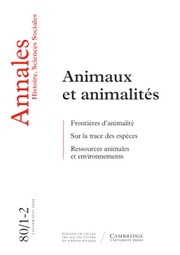Article contents
Stabilité et perfection d'un système agricole : la châtellenie de Furnes*
Published online by Cambridge University Press: 26 July 2017
Extract
L'histoire rurale en Belgique a surtout été attentive à la Flandre, où domine le « jardinage » que l'on retrouve aussi en Brabant. Mais l'agriculture des autres provinces s'en écarte nettement : c'est le cas de la châtellenie de Furnes dont on peut suivre l'évolution entre 1550 et 1645. 1500 : c'est le point de départ d'une série d'évolutions économiques et politiques aux Pays-Bas; en 1645 s'achève une période très favorable à cette région, et les Pays-Bas sont entraînés à leur tour dans la guerre de Trente Ans.
Summary
This article is a study of agriculture in the Kasselrij Veurne (45 000 ha.) between 1550 and 1645. In 1550, there were about 24 000 people living in this area, i.e. 53 people per sq. km, the actual number of people being strongly influenced by political events. The land was farmed in units averaging between 10 and 25 ha in the polders and between 5 and 15 ha in sand-loam soil areas. The greater part of the land (63%) belonged to the former class. From a technical point of view, the farming methods employed were very modern, with few fallow periods and with no rigid crop-rotation system. There was also extensive cattle-breeding, both for dairy-production (2 800-3 400 litres of milk per cow per year) and for meat-production. Agricultural output was very high in the second half of the 16th century (between 29 and 43%) and during the first half part of the 17th century (between 7 and 28%). Looked at in a medium and a long-range perspective, agriculture in this region developed slowly without undergoing any crucial change.
- Type
- Les Sociétés Agraires
- Information
- Copyright
- Copyright © Copyright © École des hautes études en sciences sociales Paris 1981
Footnotes
Cet article s'appuie sur notre thèse de doctorat intitulée « Geschiedenis van de landbouw in de Kasselrij Veurne, 1550-1645 », Gand, 1979. Il a fait l'objet d'un exposé au séminaire du Collège de France et a bénéficié des remarques de Mme M.-J. Tits-Dieuaide.
References
1. Vries, J. De, The Dutch rural economy in the golden âge, 1500-1700, New Haven-Londres, Yale Univ. Press, 1974, p. 49 ss.Google Scholar
2. Jacquart, J., Crise rurale en fie-de-France, 1550-1670, Paris, 1974, p. 110.Google Scholar
3. J. Jacquart, op. cit., p. 616.
4. Baars, C., « Boekhoudingen van de landbouwebedrijven in de Hoekswaard uit de zeventiendeen achttiende eeuw », A.A.G. Bijdragen, n. 19, Wageningen, 1975, p. 18.Google Scholar
5. J. de Vries, op. cit., p. 143.
6. J. Jacquart, op. cit., p. 65 ; Cabourdin, G., Terre et hommes en Lorraine du milieu du XVIe siècle à la guerre de Trente Ans, Lille, Service de reproduction des Thèses, 3 vols, 1975, p. 521 Google Scholar ; Goubert, P., Beauvais et le Beauvaisis de 1600 à 1730, Paris, 1960, pp. 95–113.Google Scholar
7. P. Goubert, op. cit., pp. 190-196 ; J. Jacquart, op. cit., p. 465.
8. Morineau, M., dans Braudel, F. et Labrousse, E., Histoire économique et sociale de la France, Paris, 1977, p. 978.Google Scholar
9. Spooner, F. C., The international economy and monelary movements in France, 1493-1725, Cambridge, Mass., 1972, p. 313 Google Scholar ; Klein, W., « De Zeventiende Eeuw », dans De Economische Geschiedenis van Nederland sous la direction de J. Van Stuijvenberg, Groningen, 1977, p. 80 Google Scholar ; Wyczanski, A., « Le revenu national en Pologne au xvie siècle. Premiers résultats », Annales E.S.C., n° 1, 1971, pp. 105–113.Google Scholar
- 2
- Cited by


